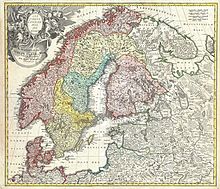
Back تاريخ الدنمارك Arabic Historia de Dinamarca AST Danimarka tarixi Azerbaijani Гісторыя Даніі Byelorussian История на Дания Bulgarian Historija Danske BS Història de Dinamarca Catalan Dějiny Dánska Czech Hanes Denmarc Welsh Danmarks historie Danish
This article needs additional citations for verification. (March 2021) |

The history of Denmark as a unified kingdom began in the 8th century, but historic documents describe the geographic area and the people living there—the Danes—as early as 500 AD. These early documents include the writings of Jordanes and Procopius. With the Christianization of the Danes c. 960 AD, it is clear that there existed a kingship. King Frederik X can trace his lineage back to the Viking kings Gorm the Old and Harald Bluetooth from this time, thus making the Monarchy of Denmark the oldest in Europe.[1] The area now known as Denmark has a rich prehistory, having been populated by several prehistoric cultures and people for about 12,000 years, since the end of the last ice age.
Denmark's history has particularly been influenced by its geographical location between the North and Baltic seas, a strategically and economically important placement between Sweden and Germany, at the center of mutual struggles for control of the Baltic Sea (dominium maris baltici). Denmark was long in disputes with Sweden over control of Skånelandene and with Germany over control of Schleswig (a Danish fief) and Holstein (a German fief).
Eventually, Denmark lost these conflicts and ended up ceding first Skåneland to Sweden and later Schleswig-Holstein to the German Empire. After the eventual cession of Norway in 1814, Denmark retained control of the old Norwegian colonies of the Faroe Islands, Greenland and Iceland. During the 20th century, Iceland gained independence, Greenland and the Faroes became integral parts of the Kingdom of Denmark and North Schleswig reunited with Denmark in 1920 after a referendum. During World War II, Denmark was occupied by Nazi Germany, but was eventually liberated by British forces of the Allies in 1945,[2] after which it joined the United Nations. In the aftermath of World War II, and with the emergence of the subsequent Cold War, Denmark was quick to join the military alliance of NATO as a founding member in 1949.
- ^ http://madmonaco.blogspot.com/2010/06/oldest-monarchy.html http://www.royalinsight.net/content/danish-monarchy-overview Archived 2012-10-15 at the Wayback Machine
- ^ The remote Danish island of Bornholm in the Baltic Sea was liberated by Soviet forces of the Allies. This led to some political turmoil and conflict, occasionally resurfacing in modern times.
© MMXXIII Rich X Search. We shall prevail. All rights reserved. Rich X Search
